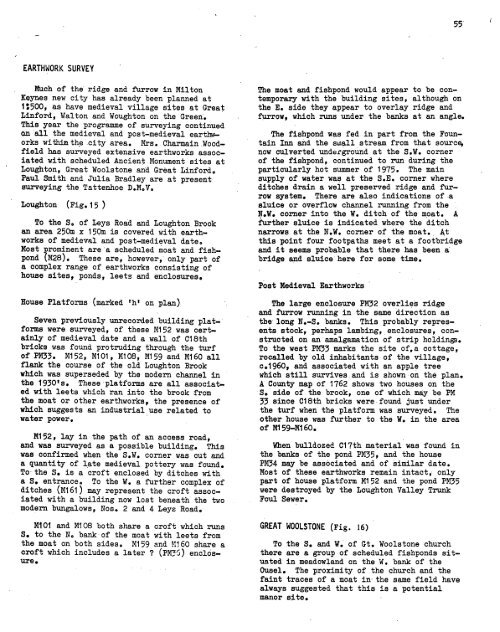Untitled - Council for British Archaeology
Untitled - Council for British Archaeology
Untitled - Council for British Archaeology
Create successful ePaper yourself
Turn your PDF publications into a flip-book with our unique Google optimized e-Paper software.
55<br />
EARTHWORK SURVEY<br />
Much of the ridge and furrow in Milton<br />
Keynes new city has already been planned at<br />
1500, Aa have medieval village sites at Great<br />
Lin<strong>for</strong>d, Walton and Woughton on the Green'.<br />
This year the programme of surveying continued<br />
an all the medieval and postmedieval earthworks<br />
witKinthe .city area. Mrs. Charmain.Woodfield<br />
has surveyed extensive earthworks associated<br />
with scheduled Ancient Monument sites at<br />
Loughton, Great Woolstone and Great Lin<strong>for</strong>d.<br />
Paul Smith and Julia Bradley are at present<br />
surveying the Tattenhoe D.M.V.<br />
Loughton (Fig.15 )<br />
To the S. of Leys Road and Loughton Brook<br />
an area 250m x 150m is covered with earthworks<br />
of medieval and postmedieval date.<br />
Most prominent are -a scheduled Moat and fishpond<br />
(M28). These are, however, only part of<br />
a complex range of earthworks consisting of<br />
house sites, ponds, leets and enclosures.<br />
House Plat<strong>for</strong>ms (marked 'hl on plan)<br />
Seven previously unrecorded building plat<strong>for</strong>ms<br />
were surveyed, of these M152 was certainly<br />
of medieval date and a wall of C18th<br />
bricks was found protruding through the turf<br />
of PM33. M152, M101, M108, M159 and M160 all<br />
flank the course of the old Loughton Brook<br />
which was superseded by the modern channel in<br />
the 1930's. These.plat<strong>for</strong>ms are all associated<br />
with leets which ran into the brook from<br />
the moat or other earthworks, the presence of<br />
which suggests an industrial use related to<br />
water power.<br />
M152, lay in the path of an access road,<br />
and was surveyed as a possible building. This<br />
was confirmed when the S.W. corner was cut and<br />
a quantity of late medieval pottery was found.<br />
To the S. is a croft enclosed by ditches with<br />
a S. entrance. To the W. a further complex of<br />
ditches (M161) may represent the croft associated<br />
with a building now lost beneath the two<br />
modern bungalows, Nos. 2 and 4 Leys Road.<br />
M101 and M108 both share a croft which runs<br />
S. to the N. bank-of the moat with leets from<br />
the moat on both sides. M159 and M160 share a<br />
croft which includes a later ? (PM735) enc16s-<br />
Ure.<br />
The moat and fishpond would appear to be contemporary<br />
with the building sites, although on<br />
the E. side they appear to overlay ridge and<br />
furrow, which runs under the banks at an angle.<br />
The fishpond was fed in part from the Fountain<br />
Inn and the small stream from that source,<br />
now aulverted underground at the S.W. corner<br />
of the fishpond, continued to run during the<br />
particularly hot summer of 1975. The main<br />
supply of water was at the S.E. corner where<br />
ditches drain a well preserved ridge and furrow<br />
system. There are also indications of .a<br />
sluice or overflow channel running from the<br />
N.W. corner into the W. ditch of the moat. A<br />
i'urther sluice is indicated where the ditch<br />
narrows at the N.W. corner of the moat. At<br />
this point four footpaths meet at a footbridge<br />
and it seems probable that there has been a'<br />
bridge and sluice here <strong>for</strong> some time.<br />
Post Medieval Earthworks<br />
The large enclosure PM32 overlie's ridge<br />
and furrow running in the same direction as<br />
the long N.S. banks. This probably represents<br />
stock, perhaps lambing,enclosures, constructed<br />
on an amalgamation of strip holdings.<br />
To the west FM33 marks the site of.a cottage,<br />
recalled by old inhabitants of the village,<br />
c.1960, and associated with an apple tree<br />
which still survives.and is shown on the plan.<br />
A County map of 1762 shows two houses on the<br />
S. side of the brook, one of which may be PM<br />
33 since C18th bricks were-found just under<br />
the turf when the plat<strong>for</strong>m was surveyed. The<br />
other house was further to the W. in the area<br />
of M159M160.<br />
When bulldozed C17th material was found in<br />
the banks of the pond PM35, and the house<br />
PM34 may be assOciated and of Similar date.<br />
Most of these earthworks remain intact,- only<br />
part of house plat<strong>for</strong>m M152 and the pond PM35<br />
were destroyed by the Loughton Valley Trunk<br />
Foul Sewer.<br />
GREAT WOOLSTONE (Fig. 16)<br />
To the S. and W. of Gt. Woolstone church<br />
there are a group of scheduled fishponds situated<br />
in meadowland on the W. bank of the<br />
Ousel. The proximity of the church and the<br />
faint traces of a moat in the same field have<br />
always suggested that this is a potential<br />
manor site.

















